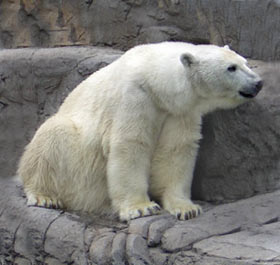Bear
 Since bears are the largest land carnivores in both Europe and the Americas, they have attained a status as ferocious beasts. They are actually omnivores; they eat fruit, nuts, honey, and meat. As the saying goes, some bears are more afraid of us than we are of them. Black and brown bears have learned to fear humans for the most part, but will occasionally meander into human-inhabited areas if they are hungry enough. Polar bears, however, do not fear us. Because of their environment, food is scarce in the summer, so they seek other means of getting food, like going into human towns.
Since bears are the largest land carnivores in both Europe and the Americas, they have attained a status as ferocious beasts. They are actually omnivores; they eat fruit, nuts, honey, and meat. As the saying goes, some bears are more afraid of us than we are of them. Black and brown bears have learned to fear humans for the most part, but will occasionally meander into human-inhabited areas if they are hungry enough. Polar bears, however, do not fear us. Because of their environment, food is scarce in the summer, so they seek other means of getting food, like going into human towns.
Pertaining to their symbolism, bears are representative of all initial stages and primal instincts. They are also strongly associated with humans in Native American tribes because bears can walk on their hind legs. Bears were extremely important to many tribes in the Americas, so much so that they had to get permission to hunt them. Some Native American tribes would hold special ceremonies after killing a bear, and the dead body would always be handled with great respect. Just the fact that the bear is in the sky as the constellation Ursus Major is enough to tell us how respected and honored bears are, and how old the custom is.
Because some Native Americans saw bears as akin to humans, the bear appeared in many morality plays. This is a good indication to us which traits these peoples admired and which they scorned. Since bears could walk upright, they were thought to be special and know all things, and so they were symbols of wisdom and medicine. Bears are also associated with the warrior spirit, prosperity, and the harvest.
Information from Ted Andrews's Animal-Speak, Jessica Dawn Palmer's Animal Wisdom, and Steven D. Farmer's Power Animals.

